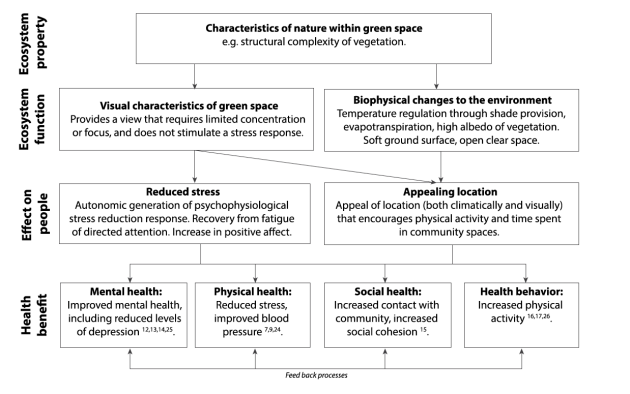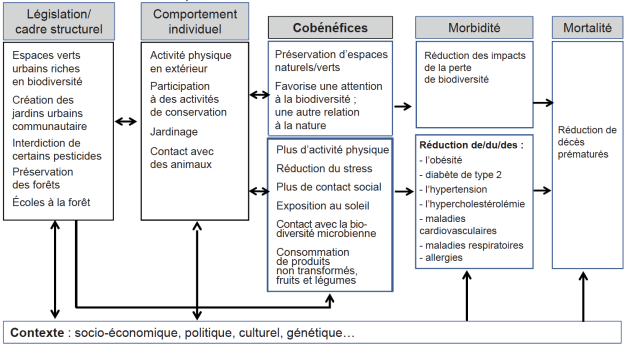Co-benefits of contact with nature
Western modernity has led to a reduction in contact with nature and other non-human life forms. A number of factors explain this trend, but we can probably start by mentioning modern cosmology and the dominant urban social organisation, which have created a clear separation between humans on the one hand, and natural environments and non-human living beings on the other. Understanding and better characterising the links between the health of ecosystems and human health could help strengthen efforts to protect natural areas and biodiversity. On a global scale, this means recognising the dependence of human societies on the equilibrium of ecosystems. On a more local scale, it involves raising awareness of the benefits that regular contact with nature can bring to individuals and communities.
Health benefits of contact with nature
The scientific literature has provided evidence that spending time in nature, being exposed to green spaces, blue spaces or biodiversity, has beneficial effects on health. A systematic review and meta-analysis published in 2018 suggest that there is a relationship between access to green spaces and improvements in a number of health indicators. These include: reduced blood pressure, reduced incidence of type II diabetes, stroke, overall mortality and cardiovascular mortality. These studies also show positive effects on pregnancy, cholesterol levels and children's health. The results of the studies also converge in suggesting strong associations between mental health and contact with nature. It also appears that the quality of natural environments plays an important role: for example, the benefits of urban green spaces seem to be directly linked to their biodiversity.
Several hypotheses are being explored to explain this relationship between nature and well-being:
Natural and green spaces promote health by providing opportunities for physical activity. Beyond being a simple place for exercise, natural environments appear to have an intrinsic additional benefit, since similar physical activity will be more beneficial if carried out in a natural environment than in an artificial one.
Green public spaces have been associated with social interaction, which may help to improve general well-being.
Exposure to sunlight, which is thought to counteract seasonal affective disorder and is also an important source of vitamin D.
Visiting green spaces increases exposure to various micro-organisms, such as bacteria, protozoa and helminths, which are abundant in nature and can play a key role in the development of the immune system and the regulation of inflammatory responses. As the human microbiome is strongly influenced by the microbial biodiversity present in the environment (from childhood and throughout life), exposure to certain micro-organisms in the environment could modulate the functioning of the immune system.
Other potential mechanisms include the cooling effect of green spaces on surface temperature, and their ability to attenuate environmental factors such as air and noise pollution.
The health benefits associated with contact with nature stem from a complex combination of all these mechanisms, itself influenced by the diversity of interpretations of notions of ‘nature’ and the subjective nature of the experience (the result of cultural factors, individual values and aesthetic judgements).
In practice: community gardens, urban green spaces and nature prescriptions
Community gardens help to improve the local environment while having a positive impact on people's health. Gardening is generally associated with emotional, social and physical health benefits. By providing a shared space where people from the same community can grow food together, community gardens amplify these benefits and act as a link for strengthening social ties and empowering communities. Their development makes it possible to produce local food, integrate nature into urban environments, bring communities closer together, promote physical activity and healthy eating, and develop vernacular skills and knowledge. These structures help to reduce food waste and encourage the consumption of local and minimally processed products, thereby reducing greenhouse gas emissions linked to the transport, processing and storage of food. What's more, these spaces can help to enrich biodiversity in the urban environment.
Urban green spaces have an essential role to play in ecological and social bifurcation strategies. Green spaces are needed to improve the quality of life in large urban areas and to meet the growing challenges of climate change and biodiversity loss. These spaces help to reduce high temperatures in cities and offer refuge during heatwaves, the frequency and intensity of which are expected to increase as a result of climate change. In addition, environmental factors are among the many potential explanations for social inequalities in health. Studies have shown that low-income neighbourhoods have fewer green spaces, and that their residents are less inclined to use those that do exist. The quality of parks and their frequency of use are generally higher in neighbourhoods with a higher socio-economic status. Urban planning that includes the promotion of green spaces among disadvantaged populations could help to reduce social inequalities in health.
Nature prescription is defined as ‘the prescription of an activity involving spending time outdoors with the aim of benefiting health and well-being’. It is increasingly described in the literature and is the subject of experiments in various countries. Nature prescriptions are generally issued by a health professional or social services provider, who recommends a specific period to be spent in a natural setting. In Canada, for example, the recently launched PaRx programme allows any approved healthcare provider to prescribe outings to nature parks for their patients. Similar programmes also exist in the United States and the United Kingdom. Seen as a low-cost, low-risk preventive intervention, nature prescriptions are emerging as a therapeutic tool in the management of a range of chronic conditions. Nevertheless, while health professionals can only encourage patients to come into greater contact with nature, further studies are still needed to better characterise the nature of exposure from a clinical perspective and thus define the types of intervention that are useful and effective for the populations concerned.

